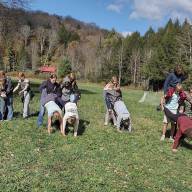Waitsfield has secured a long-awaited funding package from the U.S. Department of Agriculture to support the first phase of its municipal wastewater project – but the package looks significantly different from what town officials expected.
The USDA Rural Development package includes a $649,000 grant and a $7.5 million low-interest loan, totaling just over $8 million. The package builds on previous state federal investments in the project, bringing total USDA support to more than $12 million. That funding will help cover the first phase of a $16 million wastewater system that aims to serve Irasville, Fiddlers Green and, eventually, Waitsfield Village and the elementary school.
The town will hold a public hearing on the project on Wednesday, September 24, to walk people through the details of the funding, design progress, and next steps. Select board member Chach Curtis said the USDA’s contribution – while vital – reflects a new and more difficult funding environment under the current presidential administration.
“Big picture, the whole funding landscape has changed since the election,” Curtis said. “Not trying to get all political, but a lot of grant money has been clawed back – money that was either already awarded or in process.”
The town had once envisioned a much more favorable grant-to-loan ratio. At one point, officials hoped that up to 90% of the $16 million project could be funded by grants, particularly from sources like the federal Inflation Reduction Act and Congressional-directed spending. But in recent months, much of that funding has disappeared.
“Congressional earmarks were supposed to cover a significant chunk. That program’s been shut down,” Curtis said. “We had $5 million from the state of Vermont through the Clean Water State Revolving Fund for a pollution control grant. We qualified, but the state says that money just isn’t available right now. Maybe later. Not today.”
FUNDING LOST OR FROZEN
In total, Curtis said more than $10 million in potential funding has either been permanently lost or temporarily frozen due to shifting federal and state priorities. That has forced the town to reconsider how to move forward while keeping the project affordable for users.
Despite those challenges, Curtis emphasized that the USDA "moved heaven and earth" to deliver the current package, in large part because the project ranks as the highest-priority wastewater initiative in the state, according to Vermont’s Department of Environmental Conservation.
“This project checks every box,” Curtis said. “It improves water quality, supports village-scale development, addresses failed septic systems, and even helps the state meet its school expansion goals. That’s why it’s at the top of the list.”
The full $16 million project includes building a treatment facility near the Munn field and a collection system that will serve Waitsfield Village and Irasville. Because of current financial constraints, the town is considering building the system in phases.
Phase one – which the USDA’s $12 million package supports – would focus on the treatment system and the collection network in Irasville and Fiddlers Green. The second phase extends the system to Waitsfield Village and the school.
‘PHASING NOT IDEAL’
“Phasing it isn’t ideal,” Curtis admitted. “It takes longer and costs more. But it could give us more time to source additional grants or wait for interest rates to come down.”
The USDA loan comes with a 4.25% interest rate over a 40-year term. Annual debt service could approach $500,000, Curtis said, raising concerns about how to structure user fees that remain affordable under federal affordability guidelines.
“To be eligible for this USDA funding, we have to meet an affordability test,” Curtis explained. “That means annual user fees need to be under 2.25% of median household income. That translates to around $70 to $80 per month for the average user. That’s the number we’ve always used, and we’re still committed to keeping it affordable.”
That affordability threshold depends on how the service area is defined – a nuance the town is still working out with USDA and state officials. Different agencies use different definitions for median household income, and Waitsfield is seeking clarity on whether the eligibility calculation should be based on the full town or just the Irasville area.
Another key question remains: Does accepting the USDA package limit the town’s ability to seek future funding?
“We’re still figuring that out,” Curtis said. “It’s a good question, and we’ll have more answers by the September 24 meeting. We want to know if we accept this, are we locked in? Can we take less of the loan if we get more grants later? Those are questions we’re working on.”
PURSUING ADDITIONAL FUNDING
The town is continuing to pursue additional funding from programs like the Northern Border Regional Commission and Community Development Block Grants. Those agencies prefer to fund standalone portions of projects, which aligns well with the town’s phased approach – particularly if the second phase can be reframed as a school-specific initiative.
In the meantime, town officials are pushing forward with final design work, funded by federal and state ARPA dollars. Getting to a shovel-ready stage, Curtis said, is critical for attracting more support.
“The closer we get to final design, the better our odds,” he said. “We’ve already done the environmental permitting and a lot of the legwork. Agencies want to see that.”
He is confident that the town will make the project happen, despite the shifting federal funding landscape.
“There’s too much riding on this. We should have done it 10 years ago,” he said. “We’re going to find a way to make it work, in a way that’s fair and affordable for the community. Failure is not an option.”













